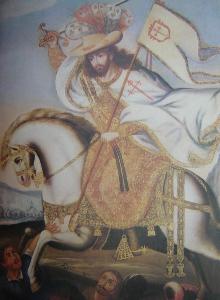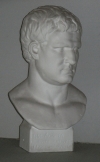Cross of St. James
The Cross of St. James has a pointed base making a Fitched Cross.
Such pointed crosses are said to have been carried in ancient times by Christian pilgrims, to thrust securely into firm ground. They would then kneel before this upright cross for prayer. The Cross of St. James is also seen as a spear or sword blade, hence yet another name – a warrior's cross. But which warrior? Who was Saint James?
The men called James
The Greek names Jacobus and Jacob (English: James) was a common name in the 1st century and several are mentioned in the Bible. To confuse matters further, their identities sometimes appear to overlap:
St. James the Greater
Two of the Twelve Apostles were named James and one of these, St. James the Greater, was the son of Zebedee, a wealthy fisherman who worked on the Lake of Galilee. His mother, the rather pious Salome, was the daughter of a priest, and his younger brother was John the Apostle.
James was one of the original disciples and a very close associate, possibly a cousin, of Jesus. He worked as a fisherman alongside Peter and these were two of the four Apostles to whom Jesus said "Come after me and I will make you fishers of men." James was present at the transfiguration, at the raising of Jairus' daughter and in the Garden of Gethsemane.
It seems that the zealous temper of James and his leadership of the Jewish Christians, led Herod Agrippa I to choose him to be the first Apostle to be martyred. The man who brought James to trial was so moved by James's testimony that he became a Christian and was decapitated (by sword) with James in 42 AD.
The remains of James are believed to be entombed in Compostela, northwest Spain. The Spanish name for James is Santiago; therefore the shrine is called Santiago de Compostela. Since the Middle Ages, countless European pilgrims have visited this tomb.
This Spanish connection is from the assumption that James used his seafaring knowledge as a fisherman to take Christianity to Spain, although this is doubted by some scholars. No authentic writings have been found to support this notion and when Paul wrote to the Romans in 58 AD, he said he'd go to Spain "to preach the Gospel where Christ was not known". Nevertheless, it is understood that the relics of St. James were at some time taken to Compostela.
Although James was a zealous 'son of thunder', the title of St. James the Greater is simply to differentiate him from the following...
St. James the Lesser
The odd-sounding title 'the Lesser' simply means 'the younger' or 'the shorter', or 'the less-influential-in-some-way'.
His mother was Mary and his brother was Joseph (or Joses). The name of his father was Cleophas (or Clopas), but he could also have had another name; Alpheus. (It was not unknown for people to have more than one name, using Hebrew and Greek or Latin.)
There is evidence to suggest that St. James the Lesser is the same as the following...
St. James the Just
James was a brother of Jesus and probably the author of the Epistle of James in about 47 AD.
Even in today's society, precise relationships are sometimes difficult to establish, and so we cannot be certain that 2,000 years ago James was genetically related, a half-brother or something else. However, other references do show that Mary and Joseph had sons and daughters.
At first, James was skeptical about the importance of Jesus and his ministry. But when James saw that Jesus had risen from the grave, he became a devout believer. Some time later he became head of the elders (a bishop) of the Early Church in Jerusalem.
James was martyred in 62 AD by the priestly authorities of Jerusalem.
St. James the Righteous
This is another title which is sometimes used for St. James the Just (see above).
James, the brother of Judas
Here we find a father and son called James. Judas had a brother named James (this Judas was not the same as Judas Iscariot who betrayed Jesus). The brother James was presumably named after his father.
Judas was known as Judas Jacobi because his father (Jacobi/James) was well known in the Early Church.
Then there's one more Saint James:
St. James of the Marches
This poor 15th century Franciscan crusading friar was born in Italy in 1391. The Marches in his name has nothing to do with marching crusading soldiers; rather it is the name of the mountainous and hilly region in Italy facing the Adriatic Sea. It was here that James preached for some 50 years soon after he was ordained in 1420 and is credited with several miracles.
He preached at more than one crusade against the Turks and following the death of St. John Capistran, James worked in Hungary as John's successor. He organised montes pietatis, a sort of charitable credit union for the poor, and preached all over Italy.
He died in Naples in 1476 and his body is buried there in the Franciscan church of Saint Maria la Nuova. He was beatified by Urban VIII in 1624, canonized by Benedict XIII in 1726, and became one of the patron saints of Naples.
Despite his military connections, the Cross of St. James is not attributed to this saint.
The cross of St. James

A knight of St. James, killer of Moors
It is St. James the Greater (see above) who is the patron of the Order of Saint James of Compostela (see also Compostelan Cross). This military order of knights began in the year 1171, to protect pilgrims visiting St. James's shrine. They also built and staffed hospitals on the roads leading to Compostela, known as St. James's Way.
For over a thousand years, people have followed the route of the setting sun on their pilgrimage to Santiago de Compostela. At night, a stream of stars in the sky (the Milky Way) pointed in the same direction. This became known as the Pilgrim's Way or St. James's Way. The journey was usually made on foot and in the 12th century, 500,000 pilgrims are understood to have made the journey each year. Now, over 5,000,000 people arrive in Compostela each year, sometimes on foot, but more often on bicycles, cars or tour buses.
The order spread and became well known in other countries. At one point, 80 of the 400 knights were commanderies with control over 2 cities, 178 towns and 200 parishes. They also managed hospitals, convents and a college in Salamanca on Spain's Northern Plateau. Although primarily a Spanish order, they owned and managed property across the border in Portugal and France. Further afield, they controlled small parts of Hungary and Italy.
The name of the order in Spanish is Santiago de la Espada (James of the Sword). Their emblem is a sword with a Fleuried quillon (hand guard), merged with a Compostelan Shell atop the hilt.
In heraldry, a fichée is defined as having sharp pointed arms where the taper begins far from the end of the arm. This differs from the aiguisé, where the tapering begins closer to the arm end.
Matt. 4:21-22
Luke 5:2-10
Mark 5:37-43
Mark 14:33
Acts 12:1-3
Rom. 15:20-24
Mark 3:17
Mark 15:40
Matt. 27:56
John 7:5
Jude 1:1







